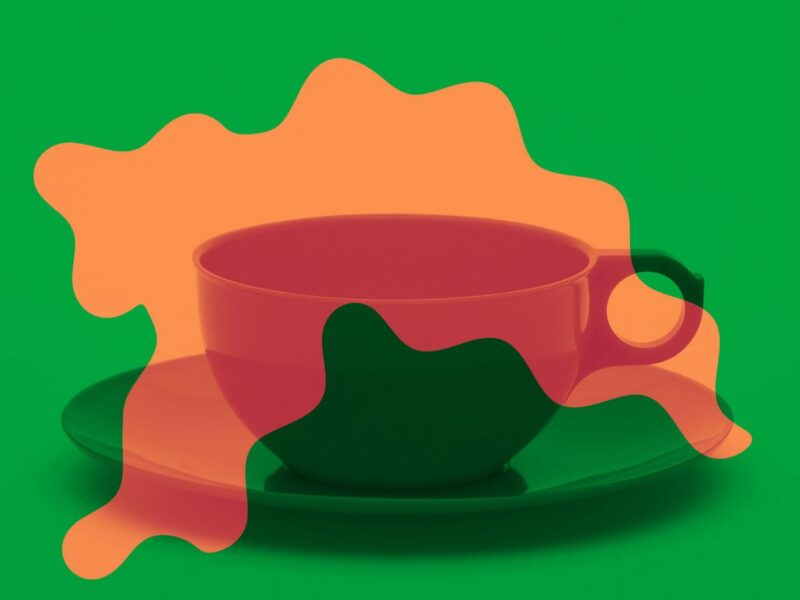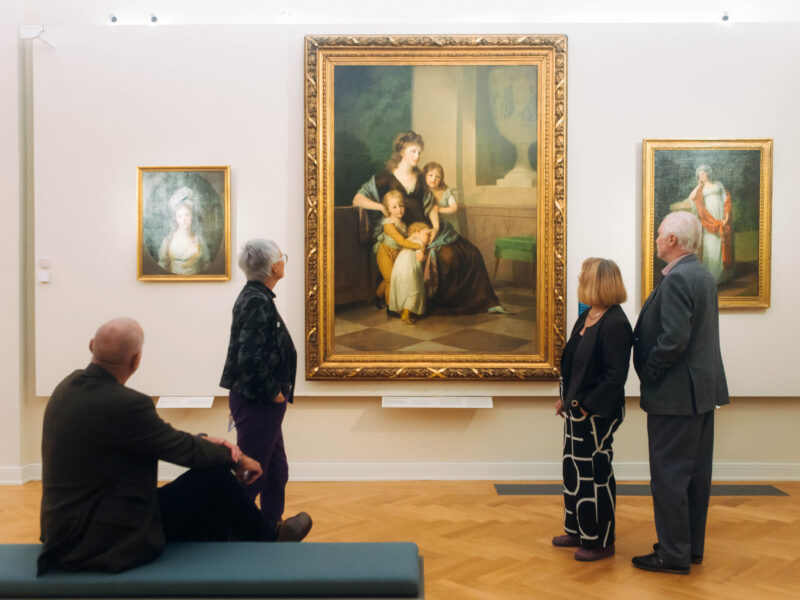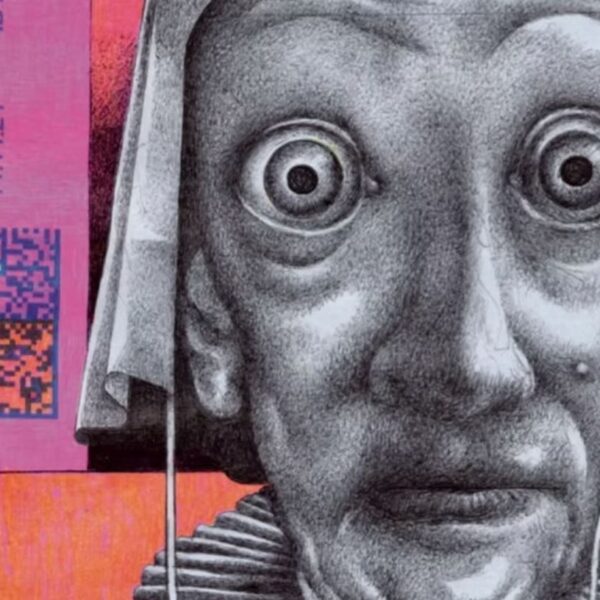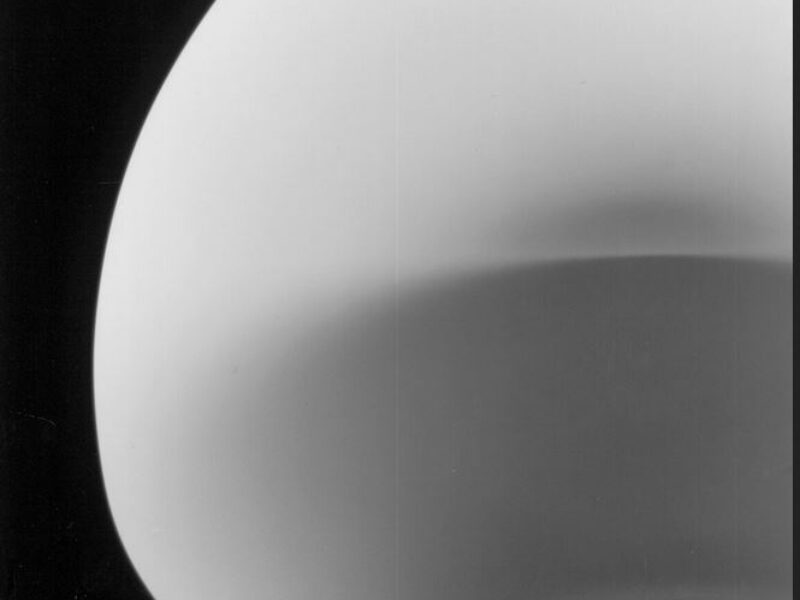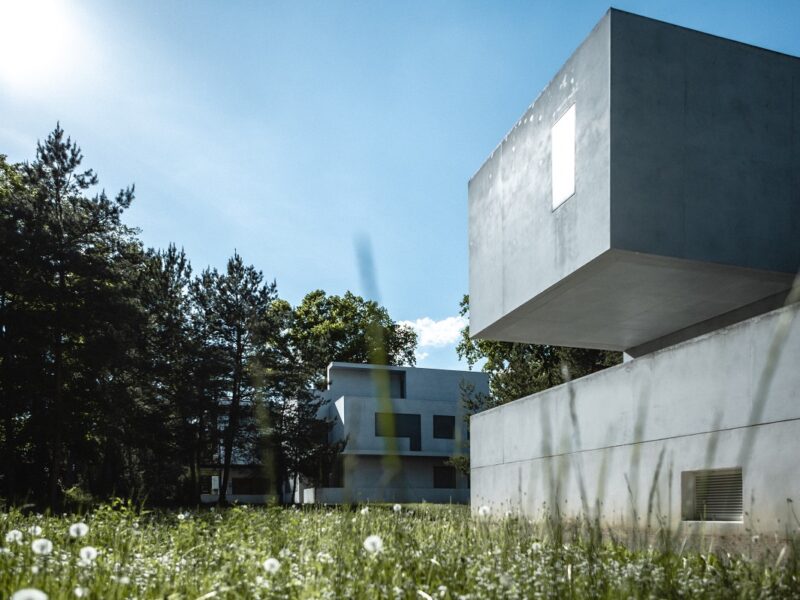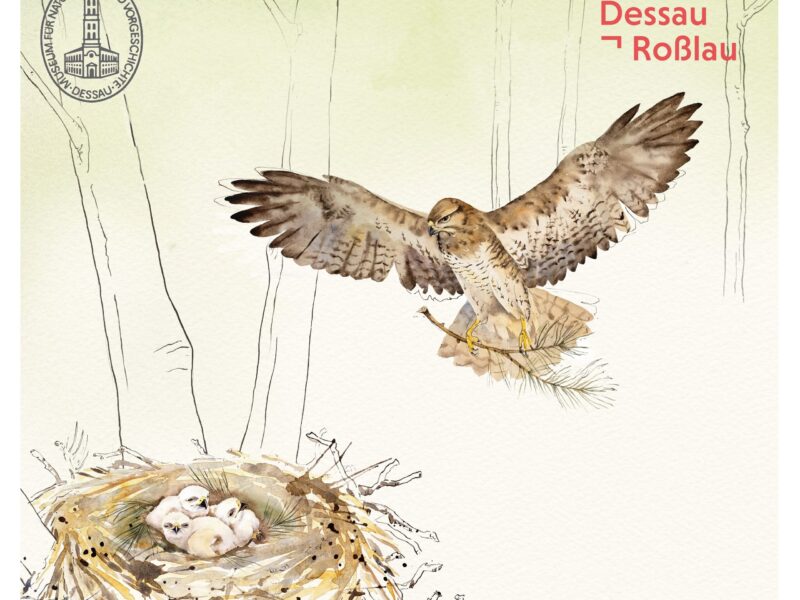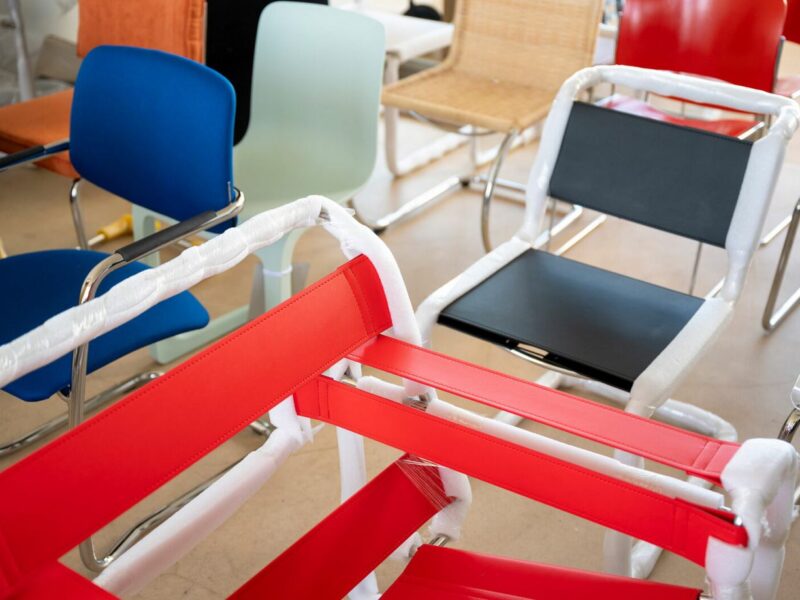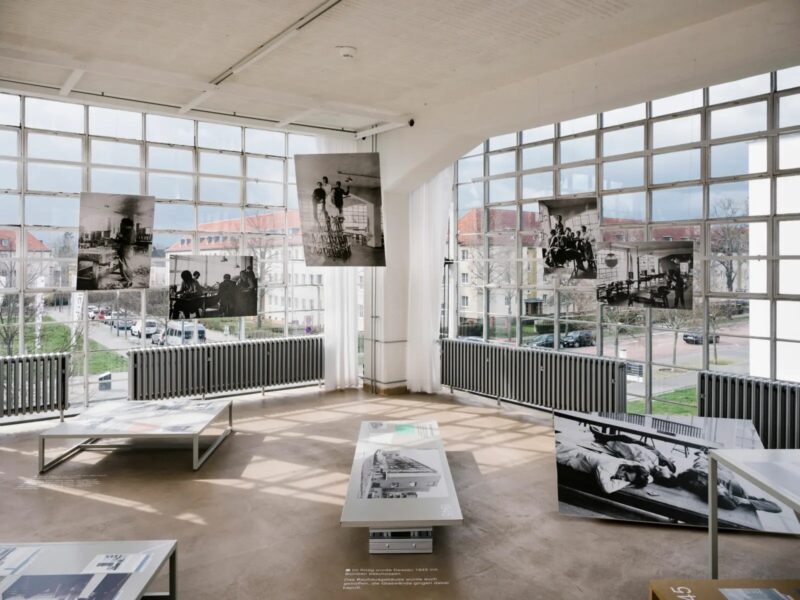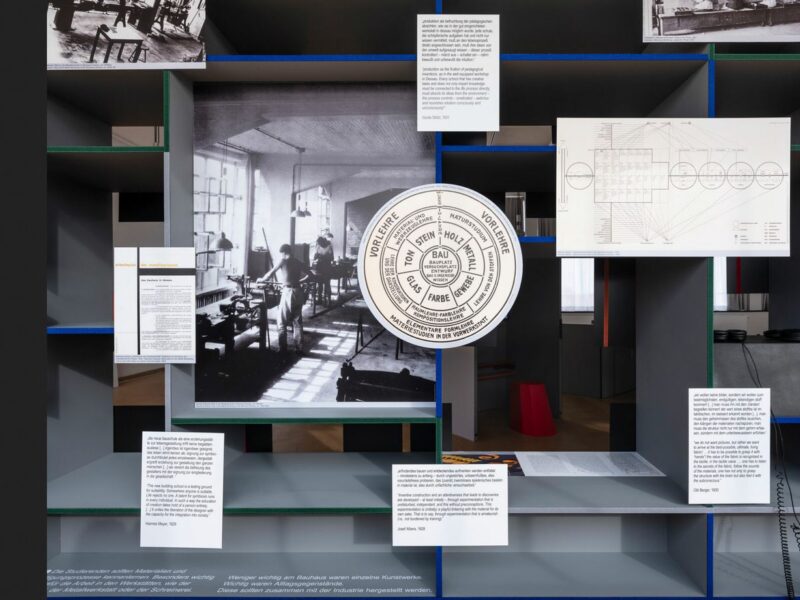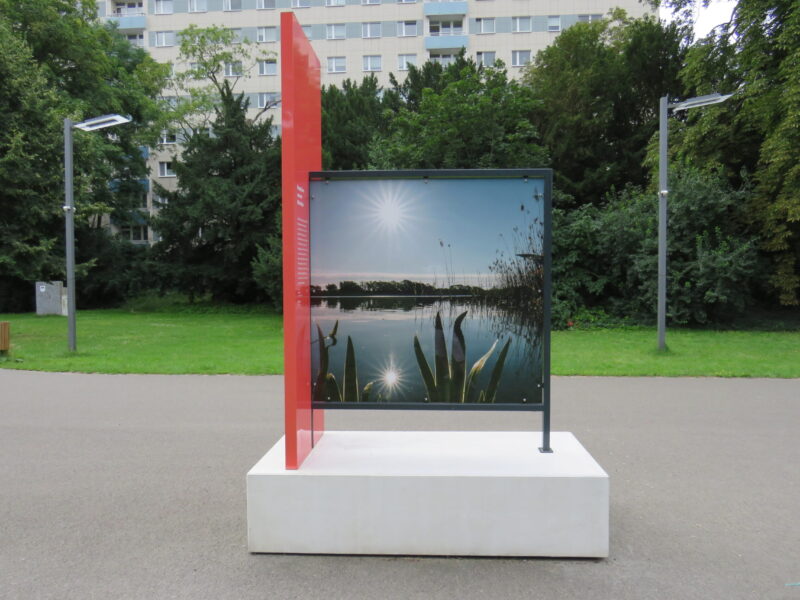05.12.2025 – 31.01.2027
Tue – Sun, 10 am – 6 pm (March – Oct)
Tue – Sun, 10 am – 5 pm (Nov – Feb)
Bauhaus Museum Dessau
Mies-van-der-Rohe-Platz 1
(at the Kavalierstraße)
06844 Dessau-Roßlau
Stiftung Bauhaus Dessau
Gropiusallee 38
06846 Dessau-Roßlau
Bauhaus Museum Dessau
Bakelite | Glaze | Colour
Since the Bauhaus Museum Dessau opened in 2019, more than 3,000 objects from over 150 donors have been added to the Bauhaus Dessau Foundation’s collection – ranging from art, design and everyday objects to photographs and elements from the building’s construction period, such as historic Bakelite light switches.
The exhibition presents a selection of these objects and shows how diverse the gifts are that enrich the collections of the Bauhaus Dessau Foundation in material, historical and narrative terms. The stories of the donors are also told: their personal motives and memories bear witness to their lively relationship with the Bauhaus in Dessau – both then and now.
01.12.2025 – 02.03.2026
We – Sun 10.00 a.m. – 06.00 p.m.
Anhalt Art Gallery Dessau
Orangery near Georgium Pallce
Puschkinallee 100
06846 Dessau-Roßlau
Anhalt Art Gallery Dessau
Puschkinallee 100
06846 Dessau-Roßlau
Anhalt Art Gallery Dessau
From Baroque to Bauhaus. Collection stories
In the winter of 2025/26, the Anhalt Art Gallery Dessau will provide an insight into its collection history and thus also into the stories surrounding the collections and collector personalities to whom it owes its valuable holdings from the Middle Ages to modern times.
During their presentation, the “collection (hi)stories” replace the permanent exhibition in Georgium Palace, which will be closed during these three months. As there, the museum’s major works from Lucas Cranach to Wassily Kandinsky are presented in the Orangery. In addition, works of art can also be seen, which are usually kept in the depots. Be it large-format canvases from the 20th century by Paul Riess, Georg Lührig and Carl Marx. Or works on paper by Albrecht Dürer, Francisco de Goya and Paul Klee, which can only be shown for a limited time. The selection is intended to reflect the breadth of the Anhaltische Gemäldegalerie’s collections.
A particular focus of the presentation is on the question of which older collections the museum received its works from (Ducal Collections, Amalien Foundation, Joachim Ernst Foundation, Municipal Art Collections, Anhalt State Collections), and thus also the question of the tradition, identity and future development of the collection.
Tue – Sun, 10 am – 5 pm
kunstHALLE Dessau
Ratsgasse
06844 Dessau-Roßlau
Anhaltischer Kunstverein Dessau e.V.
Hobuschgasse 5
06844 Dessau-Roßlau
Mail: info@anhaltischer-kunstverein.de
Exhibition in the kunstHALLE
Volker Schlecht - waste papers
Drawing as a single image, as a sequence, as a film – and film as drawing in motion – this is how Volker Schlecht’s work could be summarized. His free drawings are usually created as waste, as an incidental matter, and they are literally made from waste: he draws on used tea bags, on coffee filters, on paid receipts, on torn open envelopes, on filled out forms, on building instructions, on scraps of paper. He often draws with banal tools – ballpoint pens, felt-tip pens. For him, the quintessence of these materials is: spinning straw into gold through drawing, transforming paper waste into a picture. It’s not about nostalgic-aesthetic backgrounds, but rather the appeal lies in the “expansion” of what has been found. Drawing as a pipe shaft test. Nothing is planned, the process is (almost) everything.
Together with Alexandra Kardinar he illustrates for books, newspapers and magazines under the name Drushba Pankow. In his drawn short films, Volker Schlecht deals with political and historical themes, most recently in “Kaputt” with forced labor in the central women’s prison in the GDR and in “The Waiting” with the extinction of species and pandemics.
Since 2022, Volker Schlecht has been a professor of design/drawing in the architecture course at the Anhalt University of Applied Sciences in Dessau.
05.11.2025 – 12.07.2026
Tue – Sun, 10 am – 6 pm (March – Oct)
Tue – Sun, 10 am – 5 pm (Nov – Feb)
Bauhaus Museum Dessau
Mies-van-der-Rohe-Platz 1
(at the Kavalierstraße)
06844 Dessau-Roßlau
Stiftung Bauhaus Dessau
Gropiusallee 38
06846 Dessau-Roßlau
Bauhaus Museum Dessau
Sbstz. A Font Software
Experimental type design and the potential of digital-dynamic metamorphoses are themes of the type design collective Camelot and their multimedia installation on the spatial stage in the Bauhaus Museum Dessau. Letter forms shapeshift between different states; formal and ideological principles collide, compete and dissolve.
01.08.2025 – 01.03.2026
Mon – Sun, 10 am – 5 pm (Mar – Oct)
Tue – Sun, 10 am – 5 pm (Nov – Feb)
Bauhaus Building
Gropiusallee 38
06846 Dessau-Roßlau
Stiftung Bauhaus Dessau
Gropiusallee 38
06846 Dessau-Roßlau
bauhaus-dessau.de
Exhibition in the Bauhaus Building
After modern Brightness. Ecologies of Light
Designed by Marianne Brandt in 1926, the ME 94 lamp is the result of complex interactions between scientific and technological developments, capitalism, cultural changes caused by mass production and advertising, and ecological changes associated with the electrification of Germany.
After modern brightness. Ecologies of light illuminates these invisible interconnections by examining key environments in which electricity is generated, distributed and used. Not only is the ME 94 lamp considered in its historical context, but it is also shown how design responds to technological and social developments – from the ventilation openings in Brandt’s design to the externalized environmental costs of energy production.
A closely interconnected geography of electrification runs through the entire exhibition. Places like Dessau, Zschornewitz, Berlin and Weißwasser are connected to each other via infrastructures of extraction, energy production and consumption.
01.06.2025 – 11.01.2026
daily 10 am – 5 pm (Mar – Oct)
Tue – Sun 10 am – 5 pm (Nov – Feb)
Entrance fee Haus Gropius
Haus Gropius
Ebertallee 57
06846 Dessau-Roßlau
bauhaus-dessau.de
Masters' Houses - Gropius House
Margret Hoppe. Pair / Unpair
Margret Hoppe was a resident artist at the Bauhaus Dessau Foundation in 2024. The conceptual starting point of her photographic work was the examination of duplications. In addition to the Muche | Schlemmer House – where the artists in residence live and work – two reference images of the Masters’ Houses form the framework: a photograph by Lucia Moholy and a two-part image by photographer Benjamin Subtil. In correspondence with the Masters’ Houses, in each of which one half of the building is rotated 90 degrees, Hoppe has also rotated the back of the camera 90 degrees, creating double exposures. In her twelve-part series, Hoppe forms pairs. This happens through the double exposure in the pictures themselves or through similarities and neighbourhoods between the shots. At the same time, these pairs are repeatedly uncoupled by single images (unpair).
25.09.2024 – 01.03.2026
We – Sun, 10 am – 5 pm
The Museum is closed in December and January.
Museum of Natural History and Prehistory
Askanische Straße 32
06844 Dessau-Roßlau
Museum of Natural History and Prehistory
Askanische Straße 32
06844 Dessau-Roßlau
Museum of Natural History and Prehistory
Special exhibition “Animal Individual”
Whether sawflies or buzzards: animals deal with their environment individually. Researchers from different disciplines in the Collaborative Research Center NC³ at the Universities of Bielefeld and Münster have examined in more detail how they choose their own ecological niche, adapt to it and change it for various animal species. Their research results are clearly presented in the special exhibition “Animally Individual” on loan from Bielefeld. The exhibition invites visitors to follow in the footsteps of science themselves. At hands-on stations you can find out, for example, how experienced flour beetles protect themselves from disease or how the development of fur seal pups is influenced by the mother’s choice of beach. Research and exhibitions help to better understand animals and their behavior and thus contribute to effective animal and species protection.
permanent exhibition
Tue – Sun, 10 am – 5 pm (Nov – Feb)
Mon – Sun, 10 am – 5 pm (Mar – Oct)
Bauhaus Building
Gropiusallee 38
06846 Dessau-Roßlau
Exhibition in the Bauhaus Building
Yun Yang. More than real
In his work More than real, Jun Yang presents famous Bauhaus furniture of various origins in the historic Bauhaus building. The Vienna-based artist uses various rooms with a precise selection of furniture produced true to the original, translations and free imitations. It addresses the further developments and changes that the design heritage of the Bauhaus, specifically furniture design, has undergone over the past decades. Jun Yang’s work for the Bauhaus Dessau is about interpretations and transfers: from industrial furniture to design icons, to fetishes, to copies and to works of art. With the selection of furniture, Jun Yang rejects a strict concept of authenticity and at the same time invites people to continually renegotiate ideas of authenticity. What is authentic that needs to be preserved?
On the occasion of the centenary of the Bauhaus in Dessau, Tecta and Jun Yang are starting the experiment of developing a new, completely recyclable Wassily edition. The name “Wassily” was introduced in the 1960s by Dino Gavina as a marketing name for the Breuer B3 armchair. Tecta produces the foldable armchair under the name D4.
permanent exhibition
Tue – Sun, 10 am – 5 pm (Nov – Feb)
Mon – Sun, 10 am – 5 pm (Mar – Oct)
Bauhaus Building
Gropiusallee 38
06846 Dessau-Roßlau
Exhibition in the Bauhaus Building
The glass facade at the Bauhaus
The striking steel and glass facade of the workshop wing was a novelty when it was completed in 1926 and for a long time stood for modern building. Since its destruction due to the war in 1945, there have been repeated changes to the building. One of the most important was the reconstruction of the facade as an aluminum-glass construction in 1976. During this time, people learned to appreciate the Bauhaus again. It became (again) a place for design and architectural questions.
The exhibition traces the eventful history of the famous facade. Historical photographs show the interior and everyday life of the training center from the 1920s to the 1980s. Contemporary witnesses from different generations have their say in images and sounds.
permanent exhibition
Tue – Sun, 10 am – 5 pm (Nov – Feb)
Mon – Sun, 10 am – 5 pm (Mar – Oct)
Bauhaus Building
Gropiusallee 38
06846 Dessau-Roßlau
Exhibition in the Bauhaus Building
Bauhaus learning place
The former architecture classroom becomes an exhibition and place for visitors to stay with the “Bauhaus Learning Site”. Against the background and context of the historic Bauhaus Dessau as a school (1926–1932), current forms of learning that are practiced today in the two departments of the Academy and the Curatorial Workshop of the Bauhaus Dessau Foundation are presented here. This includes research and teaching on history and critical reflection of modern and current design discourses as well as mediation and playful-speculative reinterpretations of historical exercises, materials and ideas.
Using a selection of presented projects, visitors to this location are invited to take part in the multi-voiced conversations of these teaching programs, workshops, publications and other formats on the discourse and practice of design.
October 2025 until October 2027
The exact locations of the picture banks can be found on the map on the exhibition page.
If you have any questions, please contact the Tourist Information Dessau.
Downtown
Open Space Gallery
Take your time for a walk through the city and discover the most beautiful places of Dessau-Roßlau as photo impressions on an approximately 3.5 km long circuit between the train station and Kavalierstraße.
In this interesting format, the temporary exhibition presents appealing topics such as urban development, urban history and urban culture.
The current open space exhibition invites you to get to know personalities from the Bauhaus era in Dessau. On the tour you will meet directors, masters, students and supporters of the Bauhaus, whose work has shaped and carried forward the ideas of modernism.
The picture benches tell their story in text and images and make the diversity of the Bauhaus period in the urban space tangible.
Click here to go to the exhibition page.
